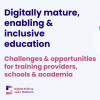AI Leap - Estonia
The Estonian AI Leap program is born out of the realisation that AI is here to stay - and that the Estonian population and workforce needs to be equipped with the know-how to reap the benefits of a digitally-transformed world. AI tools are not only widely used - they are starting to infiltrate productivity gains to such an extent that it turns out knowing how to work with them is essential. The AI Leap program's mission is to incorporate cutting-edge AI applications into its education system and provide access to AI-based educational tools (as well as training how to use them) to Estonian teachers and students.
Background and context
AI Leap is inspired by Tiger Leap, a 1990s program in Estonia that effectively laid the foundation for the country's digital achievements, which made the use of Internet and availability of computers in schools ubiquitous. The initiative was announced by Estonian President Karis during a speech on Independence Day in February 2025. It is jointly-funded by the state of Estonia and private sector stakeholders.
By design, AI Leap aims to make AI technology understandable and accessible to Estonian students, enhancing the competitive edge of the country. The initiative has also already attracted global unicorns in the tech sphere, with OpenAI, Anthropic, and Gemini taking part in the public-private partnership.
As of Autumn 2025, an initial group of 20.000 high-school students in 10th and 11th grade in Estonia will get access to a set of AI educational apps, while 3.000 teachers will receive training on how to effectively integrate them in teaching and learning activities. A long-term goal of the program is to have it expand to engage more high-school students as well as vocational schools.
About AI Leap
The long-term goal of the AI Leap program is to maintain Estonia’s high level of education, boost Estonians’ global breakthrough ability as well as Estonian capacity to develop cutting-edge solutions and products, and smoothly integrate AI into education to ensure the best possible learning. Another aim is to optimise teaching through the use of educational AI tools, thereby making it more efficient, personalised, diverse, and inclusive. Finally, the initiative wants to close the digital technology divide - and prevent a new one from opening up - between those that are AI-savvy, and those with limited know-how in the subject.
Under the guidance of the Estonian Ministry of Education and Research, relevant working groups comprised of teachers, students, academics, industry members, social partners, researchers and EdTech specialists, have already begun work on a specialised curriculum and training content.
Why is this a good practice?
The program's first training phase kicks off on 1 September 2025, with the goal of training 20.000 students and 3.000 teachers on using some of the best AI EdTech applications available. This includes initial teacher training on integrating existing digital learning applications (such as E-kool, e-koolikott) and learning software into the teaching process. The training includes an overview of the use of AI technology and recommendations on personalising learning based on students' needs to empower teaching. The program contributes to breaking stereotypes prevalent in the field by bringing forward the notion that AI will not replace jobs, but rather has to be integrated into the education ecosystem for learning and teaching to be able to respond to new demands and changing realities.
In its next stage, AI Leap will be expanded to vocational schools and new high school 10th-graders in September 2026, involving 38,000 students and 2,000 teachers. By the spring of 2027, the first students who have completed the AI Leap program will graduate from the school. Projections state that the initiative will have reached close to 60.000 students and over 5.000 teachers by that time frame.



